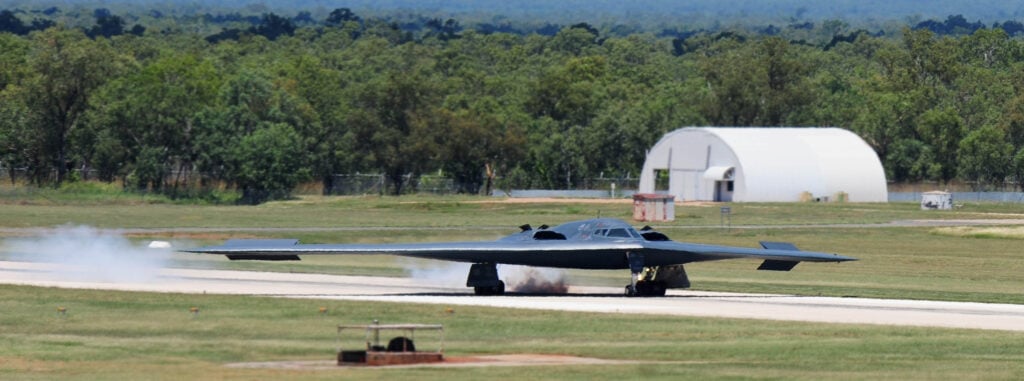ROBBIN LAIRD and ED TIMPERLAKE

The Chinese, who have been conducting economic and political warfare against Australia for several months, are now directly threatening Australia with a military strike.
In response, the Australian government has clearly indicated that it will build up its long-range strike inventory.
The recent G-7 statement about China is nice, but we have suggested that the Biden Administration do something more concrete with regard to deterrence, namely, to fly two B-2s into Northern Australia as part of an enhanced support to our core ally and to provide a concrete contribution to escalation control.
But now the question for Australia is what long-range strike capabilities it should develop or purchase from other countries, and when, how and what deterrent impact are they likely to have?
We recently discussed this question with former Air Marshal Geoff Brown, chairman of the Williams Foundation. Brown, a former F-111 operator, directly experienced the impact of long-range strike, and Ed has experienced the F-111 during his time in the air in Cambodia when flying his F-4. The F-111 fighter-bomber entered RAAF fleet service in 1973 and was retired in 2010.
Brown sees long-range strike as a flexible element for crises within the future ADF tool kit: “I think long-range strike is about trying to keep stability in a crisis situation. And if you’re going to use it as a deterrence. It’s got to be responsive, it’s got to be potent, but you’ve also got to be able to signal that you can use it.”
The most flexible tool for those purposes, he said, is a bomber.
“If you end up in a hot war, all options are good, whether it’s cruise missiles or land based. But from a pure deterrence point of view, I think the bomber’s got some significant advantages. Crisis management is a skill set which has atrophied since the end of the Cold War. Because the advantage we’ve had since the end of the Cold War is that nobody’s had the ability to hit us back,” he said. “We have been able to fly strike airplanes from carriers or close land biases, and they not held at threat, but I think in upcoming operations, that’s changed. I think the closer you are to the fight, the more at risk those assets will be.”
The crucial difference between a bomber and sub-launched and land-launched long-range-strike “is that you do have that ability to signal. I think in any sort of crisis, everybody’s going to want to solve the crisis before you end up in a nuclear war. You need a potent conventional capability which has strategic weight to play in such a crisis situation.”
He points to the risks inherent in using other assets: “One of the advantages of a manned or unmanned bomber is that it’s much easier to signal in a crisis period than if you’re trying to launch strike from submarines. Land-based strike missiles tend to be sort of a binary approach.
And fighters are constrained by their limited range. “They can look very offensive to somebody you’re trying to deter. And it actually could have the opposite effect of what you’re after, whereas the long-range bomber is flexible. You can probably keep it safer than most other forms of strikes,” Brown said.
Effective deterrence requires both flexibility and great striking power.
“The thing that people forget is this isn’t always about objective reality. It’s really about what’s in decision-makers’ beliefs and their perceptions and their expectations. And I think that’s what people miss in the real advantage and flexibility of bomber aircraft over all the other strike options to influence the adversary’s perceptions. They’re a tremendous signaling device that actually makes people think about what they’re about to do,” the former air marshal said. “In the end, you actually don’t want to fight the war. You want stability. You can’t let the other guy think that he’s actually got a chance at getting an advantage. You’ve really got to attack that belief and his perceptions with capabilities that have strategic weight.”
In keeping with those arguments, Brown noted that our proposal of sending B-2s on a rotational basis to Northern Australia made a lot of sense as a near term contribution and to demonstrate their utility and effectiveness: “This is quite doable. A lot of the infrastructure improvements we’re actually doing in the north would support that sort of deployment anyway, it’s not as though we’re not ready to do it.”
There is a debate going on in the American defense community over whether the focus of effort should be upon build out of capabilities to operate close to China and inside their weapons engagement zone, or whether to focus on dominating the blue water maneuver space and enhancing long-range strike to go into the inside engagement zone.
Brown’s insights remind those engaged in this debate that this is about deterrence, and deterrence of a nuclear power. With the United States and its allies facing three nuclear powers in the Pacific (China, North Korea and Russia), fielding a credible deterrent force — one able to signal without triggering World War III — certainly makes sense to us.
Robbin Laird, a defense consultant and member of the Breaking Defense Board of Contributors, is a research fellow with the Williams Foundation. He recently published Joint by Design: The Evolution of Australian Defence Strategy. Ed Timberlake, a graduate of the US Naval Academy and former Marine squadron commander, works with Laird. He has worked on Capitol Hill and held senior positions in the Defense Department.
No comments:
Post a Comment